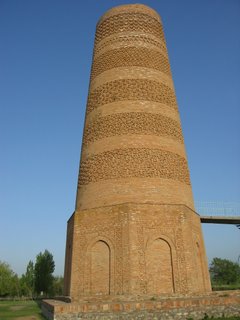
April 28, 2006
I'm lying under the covers in a Tamchy guesthouse, a village on the shores of Issyk-Kul. My plan is continue my bike ride around the lake tomorrow. I'm not sure how much the weather is going to cooperate though. After a hot, sunny day in the 90s - a heat that made the thought of packing a jacket unthinkable - I'm listening to a strong wind blowing outside. It sways with a steady hum, sometimes picking up in gusts as though it has encountered something in its path and is carrying it along.
I arrived in the darkness of night, so I haven't seen the lake yet. But I can imagine the clear waters being whipped into small waves, crashing against the shore in protest.
I'm staying in a guesthouse that is part of the Community Based Tourism network. Sonya and her husband are a middle-aged couple who live here with their daughter Alina. Their two older children are students in Bishkek. I don't know how they came upon this place, but they have a gigantic premise that accommodates up to ten guests at a time.
I love the concept of the Community Based Tourism, I like staying in local homes and knowing that the money is going to people in the community. The only bummer is that while most members provide very good service, it can sometimes be more like a hotel than staying with a family. Sonya warmed up the banya for me, and afterwards, kindly offered me tea. But I drank the tea alone at a table for ten. Listening to the wind howling outdoors, it felt a little bit lonely.
I drove to Issyk-Kul with my two colleagues, Lena and Sandra, and a friendly driver Kenche. We left the city, passing stands of fat, red radishes on the road to Tokmok. I watched a man move though the dust raised by a truck on the main road with a hand-propelled wheelchair. And I noticed the scenery tranform from extensions of Bishkek, to green fields extending out to the base of mountains, to mountains that rose up on either side of us as we drove through the Shoestring Pass.
The entire landscape is covered with a patina of green - from the green that blankets the formerly brown mountains to the green that spouts from the trees, to the green shoots emerging from the plowed fields.
Our driver pointed out the road to the Kemin district. I asked why it was special.
"That was where Akaev (the former President) grew up," he said. "So there are especially good roads there."
"Are they going to improve the roads to Jalalabat now?" I asked, referring to the current President’s place of origin.
"Of course," he said. "They've already begun. “As soon as he became president they started improving the road."
At one point, we passed a police car with a flashing light leading a group of five or six cars and marshrutkas. Several of the cars were labeled in Kyrgyz. We asked Kende what that was.
"It's probably people headed for the protest," he said. We felt we were headed in the right direction, in the opposite way.
Kende was nice enough to go a bit out of the way to take us to the Burana tower. The reddish-brown stone tower appears in just about every advertisement I see for Kyrgyzstan. Located in a field just over an hour from Bishkek, I'd never made it to see the 10th century tower, renovated in 1974.
We arrived just as the sun was receding in strength and the air cooled with evening’s approach. The tower and the museum were already closed, but it was still impressive to look at the ancient structure, as well as the 6th to 10th century gravestones scattered in the nearby field, many of them carved into the shapes of human figures representing either a deceased hero or someone he killed. They stood within a beautiful background - green trees and fields, and in the distance, green and white mountain tops. The tower marks the site of the Karakhanid town of Belasagun. Founded in 960, it became a busy market town on the Silk Road. I tried to imagine a civilization once thriving in a place now best appreciated for the clean, fresh air.



No comments:
Post a Comment